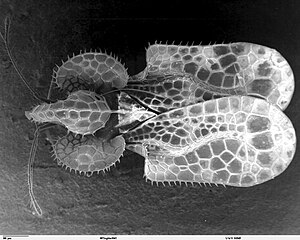Net bugs
| Net bugs | ||||||||||||
|---|---|---|---|---|---|---|---|---|---|---|---|---|

Net bug under the SEM |
||||||||||||
| Systematics | ||||||||||||
|
||||||||||||
| Scientific name | ||||||||||||
| Tingidae | ||||||||||||
| Laporte , 1807 |

Net bugs or grid bugs (Tingidae) are a family of bugs (Heteroptera). They occur worldwide with over 2000 species , of which 190 species and subspecies are represented in Europe . In Germany and Austria there are currently 75 known species, all of which belong to the subfamily of the Tinginae. The characteristic feature of these insects is the net-like structure of their upper body, which gave these animals their German name.
Outer shape
Net bugs reach body lengths between two and five millimeters. Some tropical representatives reach a maximum of eight millimeters. The adults are flat and by a netzadrige structure of the front wing ( Hemielytren ) and keeled neck shield in (pronotum). The side edge of the pronotum is widened and folded over many times. On its front edge there are often hood-shaped formations (= neck blisters) that can be so large that they hide the head. At the rear edge, the pronotum is drawn out into a long process in more developed forms, which covers the scutellum . They look similar to the report bugs (Piesmidae), but they belong to a different family group. Their wing membranes are very difficult to see under the net structure. The architecture and the number of meshes and strips as well as the construction of the antennae are important determinative features of the different species in this family.
The point eyes ( ocelli ) are regressed. Most species are airworthy due to their well-developed wings; There are also flightless short-winged species.
The larvae are more or less long, sometimes branched thorns. The characteristic grid-like structure is not yet visible in them. The larvae as well as the adults excrete wax over their body surface and therefore appear as if they have been dusted with flour.
Way of life
The animals feed on a purely phytophagous diet . Many are closely tied to just one or a few plant species or families (mono- to oligophagous). They are not very active in movement and stay mainly on the undersides of the leaves and on the flowers of their host plants. There they often hide between hair, spines or crevice-shaped depressions. They do not show any noticeable escape behavior when alarmed. Flying animals are rarely seen.
The eggs are from the females with the help of the ovipositor sunk deep into plant tissue, usually on the underside of host plant leaves, rarely on other parts of the plant or on the upper leaf surface.
Web bugs and humans
Net bugs can appear as culture pests, often with a tendency towards mass reproduction . In Central Europe they are of less importance in this regard. For example, the pear leaf bug ( Stephanitis pyri ) is considered a pest in fruit tree crops . There are also bile formers , e.g. B. Species of the genus Copium . In the tropics , however, the bugs appear to a much greater extent than pests.
Genera and species in Germany
Essentially according to (types only in selection)
- Acalypta
- Agramma
- Campylosteira
- Catoplatus
- Copium
-
Corythucha
- Corythucha ciliata - plane tree net bug
- Derephysia
- Dictyla
- Dictyonota
- Elasmotropis
- Galeatus
- Kalama
- Lasiacantha
- Oncochila
- Physatocheila
-
Stephanitis
- Stephanitis rhododendri - Rhododendron net bug
- Stephanitis takeyai - Andromeda net bug
-
Tingis
- Tingis ampliata
- Tingis cardui - thistle net bug
- Tingis reticulata
credentials
- Tingidae. Fauna Europaea, accessed November 15, 2006 .
- E. Wachmann , A. Melber & J. Deckert: Bugs. Volume 1: Revision of the bedbugs in Germany, Austria and German-speaking Switzerland, Goecke & Evers, Keltern, 2006, pp. 100–156. ISBN 3-931374-49-1
- E. Security guard: watch bugs - get to know . J. Neumann - Neudamm, Melsungen 1989, ISBN 3-7888-0554-4
Web links
Individual evidence
- ↑ H.-J. Hofmann & A. Melber: Heteroptera . In: Entomofauna Germanica . tape 6 , supplement 8, 2003, p. 209-272 .